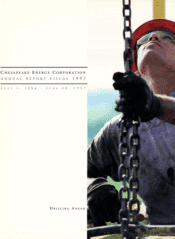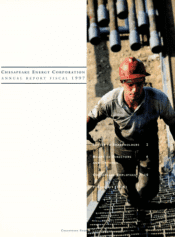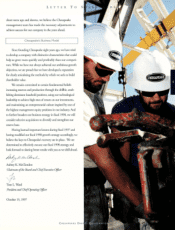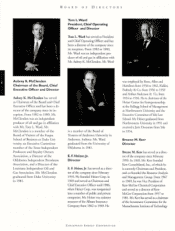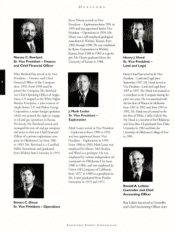Chesapeake Energy 1997 Annual Report Download - page 5
Download and view the complete annual report
Please find page 5 of the 1997 Chesapeake Energy annual report below. You can navigate through the pages in the report by either clicking on the pages listed below, or by using the keyword search tool below to find specific information within the annual report.
Dear Fellow Shareholders:
e began fiscal 1997 optimistic about the contin-
ued growth and prosperity of Chesapeake.
Unfortunately, the year ended with great disap-
pointment as we wrote down the value of the company's assets
by $236 million and incurred an after-tax loss of $183 million.
It was our first Louisiana well, the James 7, that generated
substantial enthusiasm regarding the potential of extending
"...We are also modifying our historical approach of achieving growth
exclusively through the drilibit by selectively acquiring underdeveloped
producing properties and undercapitalized companies."
A
the Austin Chalk drilling program from the Giddings Field
in Texas across the border into Louisiana. The well began pro-
ducing on June 29, 1996 and during July 1997 averaged 2,000
barrels of oil and 8.5 million cubic feet of natural gas produc-
tion per day. This well, other highly productive wells drilled by
our competitors in the Masters Creek area, and the extensive
2-D seismic control and well log information obtained from
over 500 prior penetrations of the Austin Chalk formation
seemed to confirm that the Louisiana Austin Chalk Trend
would prove productive across a large portion of central and
southeastern Louisiana.
Other companies arrived at similar conclusions, resulting in
one of the most competitive oil and gas lease acquisition efforts
in the past fifteen years over a 200 mile-long trend in Louisiana.
Chesapeake's geologists, geophysicists and landmen, along with
scores of contract lease brokers, competed aressively to
increase our position in this highly regarded acreage. By the end
of fiscal 1997, Chesapeake had invested over $175 million
acquiring more than one million acres the dominant leasehold
position in the Louisiana Trend and greater than the collective
ownership of our major competitors Union Pacific Resources,
Sonat, Occidental, and Amoco. It was clearly a major
LETTER To SHAREHOLDERS
CHESAPEAKE ENERGY CORPORATION
investment for our company. However, we believed the substan-
tial benefit of building a multi-year inventory of future drillsites
in what appeared to be the most attractive onshore exploration
play of recent years justified the inherent risks.
Consistent with our commitment to the company's share-
holders, Chesapeake initiated an agaressive exploration program
across six Louisiana Trend prospect areas: South Brookeland,
Leesville, Masters Creek, St. Landry, Baton Rouge, and
Livingston. Unfortunately, this program yielded two
conclusions as fiscal 1997 drew to a close. First, the technologi-
cal challenges and drilling costs in the Louisiana Trend were
substantially greater than we had encountered previously.
Second, the reservoir qi iility in the Louisiana Austin Chalk was
not as consistently productive as the Austin Chalk in the
Giddings Field in Texas.
Accordingly, in the last days of the fourth quarter of fiscal
1997, we determined that a
significant portion of the com-
pany's Louisiana Trend lease-
hold had become evaluated
under the full cost accounting
method, which in combina-
tion with significant related
drilling costs, caused us to
exceed our full cost ceiling limitation and required a writedown
of our assets. This writedown and the resulting loss for the year
disappointed all Chesapeake shareholders, especially us. After all,
we had personally purchased $30 million of Chesapeake stock
in February 1997, reflecting our confidence in the likely success
of the company's Louisiana drilling program. Notwithstanding
recent setbacks, we remain proud to own approximately 33% of
Oil and Gas Production Growth

